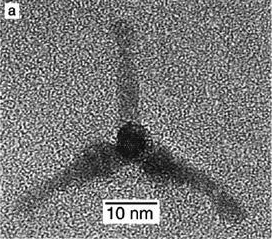Tetrapod Quantum Dot LEDs could lead to better and cheaper HDTV displays
Tetrapod quantum dots consist of an advanced nanoscale material that improves the performance and energy efficiency of high-resolution television, computer and smartphone displays.
Display manufacturers are seeking to “print” tetrapod quantum dots onto backplane films in LCD for brighter images, larger screens and a wider gamut of colors.

Quantum Materials, based in San Marco, TX, has been working to reduce the cost of quantum dot creation while ensuring uniformity in quantities sufficient to meet high-volume display manufacturing needs. Recently, the company shipped tetrapod quantum dots in sample quantities to an unidentified Asian-based electronics manufacturer, said to be a leader in the field. Quantum developed tetrapod quantum dots to meet the client’s specific performance specifications.
Quantum Materials said its patent-pending continuous-flow technology produces uniform narrow-bandwidth tetrapod quantum dots with bright emission, less aggregation, purer colors (including high-luminous red) and precise color rendition. It projects the technology will soon enable thinner, lighter, brighter and less expensive QD-LED displays, including portable and flexible devices. It will also offer almost infinite contrast levels, deep black levels and high light output with no motion blur or field-of-view issues.
“Tetrapod Quantum Dots ultimately allow for lower display manufacturing costs due to their superior luminescence and much lower incidence of aggregation,” said Stephen B. Squires, Quantum’s founder and CEO. “Far fewer quantum dots are required to achieve the same level of performance. We believe this performance advantage coupled with our continuous-flow manufacturing technology will ensure the lowest quantum dot cost.“
Earlier this month, Quantum entered into an agreement with Texas State University in San Marco, to expand the knowledge and acceptance of tetrapod quantum dots while at the same time finding new uses in the form of marketable products. The university will provide incubator companies with access to the new technology.
In a 2013, Wintergreen Research report titled Quantum Dot and Quantum Dot Display (QLED) — Markets Reach $6.4 Billion by 2019, Susan Eustis wrote that “once manufacturers learn to integrate higher efficiency luminescent quantum dots into their products, each vendor will need to follow or dramatically lose market share.
Get the TV Tech Newsletter
The professional video industry's #1 source for news, trends and product and tech information. Sign up below.
“This level of change brought by quantum dot and quantum dot displays (QLED) represents a new paradigm that will create new industries, products and jobs in science and industry,” Eustis said.
Earlier this year, Sony began shipping its Triluminos HDTVs, the first television displays made with quantum dot technology. Sony’s quantum dot technology is used to enhance the red/green/blue LED backlighting in the new generation of displays. Samsung and LG demonstrated quantum dot tech previously but have not yet announced products.
